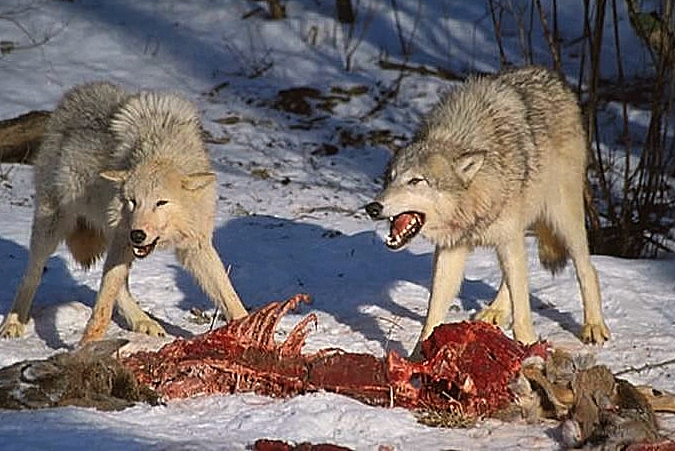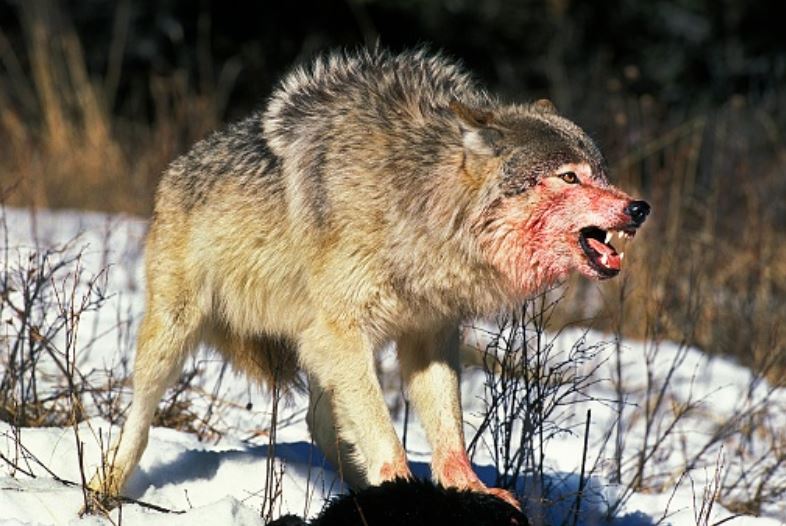‘Rewilding’ will backfire on Colorado
by Sean Paige for The Gazette
Reposted with permission of the author
The voters have spoken. Colorado has little choice now but to follow through on a ballot measure, narrowly approved in November 2020, that requires the “rewilding” of rural Colorado with imported gray wolves.
The costs, complications and potential chaos that could result remind one of H.L. Mencken’s definition of democracy, which he called “the theory that the common people know what they want and deserve to get it good and hard.” Because Coloradans (and rural Coloradans especially) are about to get what a majority of voters wanted, good and hard, it might be time to make predictions about what’s to come once imported wolves arrive en masse.
What a narrow majority of voters apparently didn’t understand when they voted “yes,” and may not understand until the fur starts flying in rural Colorado, is that such rewilding experiments never go as planned. What rewilding advocates initially promise, and what they eventually deliver, are night and day, oil and water, as events in other “rewilded” states show.
It’s relevant now not just because we’re nearing the point at which the “re-wolfing” of Colorado gets real — when the state actually unleashes these large predators on rural Colorado, with unknown consequences for residents, ranchers and recreationists. It’s relevant because Colorado is still feeling the fallout from a less heralded rewilding experiment involving Canada lynx, which were imported 20 years ago on an “experimental” basis but which are today being used as a pretext to overturn forest management plans and block ski resort expansions. It has also been reported that Gov. Jared Polis and his animal-activist husband support returning wolverines to Colorado (one of which was recently collared in Utah after mauling 18 sheep in a single attack). Grizzlies, too, are reportedly on the rewilding wish list, because things in rural Colorado just won’t be crazy enough with wolves on the loose.
The rewilding myth
Rewilding in theory is about restoring some mythical “natural balance” to vast Western landscapes, by reseeding them with species that were displaced by the westward “march of progress.” Some of those experiments can be benign and arguably beneficial. Colorado hosts a healthy population of moose today, for instance, due to a reintroduction program launched many decades ago. But these big science fair experiments become vastly more costly, complicated, controversial and threatening to public safety when large carnivores are involved. Rewilding in practice has devolved into a cynical game of bait and switch, or move-the-goalposts, in which the initial promises and rules of engagement change over time, often in ways that recognize no difference between the “old” and “new” West and put predator protection over property rights or public safety.
It’s tragic and true that many key species suffered greatly during westward expansion and settlement, large predators in particular. The systematic obliteration of these animals was a wrong we should take reasonable and realistic steps to correct — emphasis on reasonable and realistic. And I, like most Westerners, support sensible actions to protect and accommodate legitimately at-risk species, where they make sense in a modern context.
But there’s nothing reasonable or realistic about the rewilding agenda. Its advocates recognize no difference between the old and new Wests. They place no reasonable limit on how much of an animal’s “historic range” is suitable for rewilding. “Problem animals” don’t exist in the view of these folks, just problem people, so every wildlife-human conflict that occurs becomes an excuse to shame Westerners for invading and occupying “(fill in the blank) habitat.” Organized “animal advocates” have learned to manipulate the Endangered Species Act to block the delisting of species that merit removal from the endangered-species list, making wildlife management difficult.
They’re blinkered romantics who systematically ignore the social, economic and public-safety implications of what they’re doing. And they’re dishonest about their motives. They’ll say or do anything they have to get these animals into your state. But once the animals are reestablished, and they begin wreaking havoc, they’ll change the rules of the game in a way that favors the predator and disfavors predation victims, property rights and public safety.
Unintended consequences
What one finds when surveying rewilding initiatives elsewhere is that the financial and psychological impact on livestock growers is worse than initially predicted. Compensation is customarily offered as a sort of olive branch, hoping that John Q Public will see that as “fair” and worry less (if they worry at all) about the welfare of livestock growers. But such compensation programs will wither on the vine over time unless the affected states show a firm commitment to make good on those promises. I don’t view Colorado, especially under the current governor, as a state that’s supportive of ranchers or other rural residents; quite the opposite, in fact.
Montana and Wyoming are wolf- and grizzly-affected states that have stood in solidarity with their livestock growers. But that’s a reflection of the importance political leaders there place on those traditional industries. The story is much different in states led by liberals beholden to urban dwellers and the green lobby. In Oregon, Washington and California, one sees an erosion of support for compensation programs, along with diminishing support for animal-control measures aimed at preventing predation or dealing with “problem animals.” The rules of engagement in these states have shifted in a way that favors predators, not predation victims. And given Colorado’s leftward drift, as confirmed by passage of a radical ballot measure like Prop 114, livestock growers should rightly be worried about their futures here.
An alarming preview of coming attractions can be seen in Wyoming and Montana, which unwillingly became ground zero for wolf and grizzly reintroduction decades ago. Predation cases have been on a steady rise ever since, with modest fluctuation, which is forcing taxpayers to cough up larger and larger sums to compensate beleaguered livestock growers. Meat producers appreciate payment for losses, when they can be verified, but the mere presence of predators can affect the health of their herds in ways that aren’t compensated for.
Shrewd tactics
Wolves are delisted in Wyoming, thanks to congressional intervention, but grizzlies remain listed despite exploding numbers because of legal maneuvers by green extremists. They fight delisting not just because doomsaying motivates donors but because a delisted species can’t be used as a legal pretext to evict ranchers, close roads, curtail motorized recreation or derail forest restoration projects.
The offspring of wolves released into the Yellowstone area a quarter century ago now roam across a seven-state region (including the far northwestern corner of Colorado), yet wolves remain listed in most of the lower 48 states because of the legal tactics and lobbying power of Big Green. A similar situation prevails regarding the grizzly bear, whose numbers have strongly rebounded since the 1970s, in one of the greatest conservation success stories of all time. Yet it remains on the list, preventing effective management, because of the obstructionist tactics of animal advocates. Grizzlies are so numerous now that they’re wandering residential areas and becoming media celebrities — google “Grizzly 399” if you doubt it. Predation numbers are steadily rising, with no cap in sight. Last year saw an alarming uptick in mauling deaths, injuries and near-misses, as once-rare grizzly sightings become common and “grizzly country” expands to areas where the bruins haven’t been seen in a century. The animals now roam far, far beyond the original recovery zone, which has officials worried about the growing risk to unwary recreationists. Wildlife officials are running out of suitable new locales to safely relocate problem bears.
The governors of Wyoming, Idaho and Montana have petitioned the Biden administration to follow the law and the science by delisting the species. That will free them to manage the animals in a way that better safeguards public safety and mitigates property damage and economic losses. But these pleas have fallen on deaf ears in the Biden White House, beholden as it is to the green lobby.
We’ve been here before
Colorado’s experience with the Canada lynx offers another example of how rewilding games are played. It’s also a warning of potential problems.
Endangered species listings are impactful because of the flood of regulations and restrictions that accompany them. The animals themselves aren’t just physically protected; great swaths of land also are set aside by the feds as “critical habitat,” irrespective of whether the species in question is or was found there. Anyone residing, recreating or doing business within that zone can find themselves buried in red tape. And it’s that situation that might have given Colorado officials pause in the 1990s, when a push began to import Canada lynx into the state.
Colorado is marginal habitat for the cat, so to call this a “reintroduction” was a stretch. But a well-meaning Gov. Bill Owens allowed the experiment to proceed, based on assurances that the normal, onerous regulatory rules wouldn’t apply for this “experimental” population. The potential rewards seemed to outweigh the risks, given the terms of the agreement, so Colorado took the plunge and began seeding the San Juans with lynx.
As might have been predicted, the cat was a Trojan horse, which is today officially listed, despite whatever agreement and assurances were made 20 years ago, and being weaponized by extremists to fight ski resort expansion and restrict motorized access to the Rio Grande National Forest. How an “experimental population” won full-fledged protections is a complicated story, involving many legal and bureaucratic moves and machinations. But the lesson of the lynx is this: Even the most well-intended and seemingly benign rewilding experiment can have serious consequences — meaning you can’t err by assuming that what can go wrong will go wrong, in almost every case.
Wolves at the door
Colorado goes into this rewilding experiment with no clear benchmarks for measuring “success” and no clear understanding of what rules will apply when problem animals need to be managed. We don’t know what predation compensation will cost us, not just in terms of tax dollars but in terms of ranchers bankrupted and family dreams dashed. We don’t know what level of wolf conflict will warrant lethal removal or whether hunting will be permitted when the wolf population crosses a certain threshold. We also still don’t know where the animals will be released — though one can safely bet that it won’t be in the counties that favored the measure. All the state has said at this point is that ranchers have the right to “haze” or hassle wolves that are preying on their animals — whatever consolation that may be.
Other re-wolfed states understand that “hazing” rarely works. But Colorado seems determined to ignore the experience of other states and proceed as if it’s a naïve rewilding pioneer, which must learn all these lessons the hard way. And it’s plain to see, already, that the hard way is the way this is going to go.
Sean Paige is a Colorado Springs communications consultant who has been researching and writing about environmental and public-lands issues for more than 20 years. He serves on the board of the Center for Environmental Science Accuracy and Reliability.





SS, keep in mind we do not shovel,
No sense wasting time.
Carry a bernzamatic type torch to fry the signal collar if they have 1.